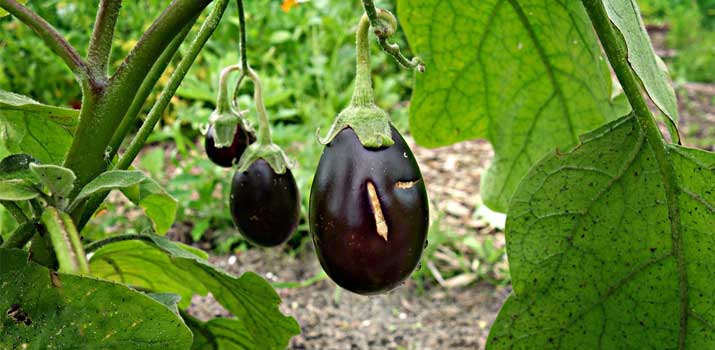
The eggplant (Solanum melongena) is an instantly recognizable vegetable popular the world over. Known for its thin, purple skin and spongy flesh, it appears in cuisines around the globe.
From tasty Tuscan pasta dishes to flavorful meals from Southeast Asia, there’s no denying the crop’s influence on cultures is far and wide-reaching.
Also known as the Aubergine, Melanzana, Brinjal, and more, the eggplant is well-known today. But a team of researchers from the Natural History Museums of London (NHM) and the Finnish museum of natural history, University of Helsinki, may have finally unlocked crucial information about the evolutionary history of the crop, unveiling more colorful origins and a curious connection to gentle giants of yesteryear.
About the Eggplant
While the eggplant is often mistaken for squash, it has no relation to that crop family. Eggplant is a member of the nightshade family (Solanaceae).
Of course, the eggplant fruit is not toxic like other nightshade berries. This purple crop is a member of the giant genus called Solanum.The Solanum genus includes about 1,400 species, and you’re likely familiar with other members like tomatoes and potatoes.
Long History
Eggplants have a long history that dates back thousands of years. Like other popular fruits and vegetables, eggplants didn’t always have widespread distribution.
Today, eggplants can grow in virtually any warm environment. But of course, they had to start somewhere! For many years, historians and horticultural experts had a general understanding of where this purple crop came from.
The consensus is that eggplant domestication first happened in Asia. Most likely, Old World humans in regions around China and India were the first to realize the crop’s potential.
Some of the earliest records come from roughly 59 BC, proving the eggplant’s longevity. From there, it moved to Europe and the Mediterranean by way of Arabic traders.
But where did the eggplant originate? Where did wild eggplant species come from, and what was the progenitor of the domesticated crop we know today? Those questions have baffled researchers for many years, but new technology has allowed researchers to look closely at eggplant DNA sequences, uncovering this fruit’s previously obscure past.
The Eggplant’s History Unveiled
Researchers from the NHM and the Finnish museum of natural history, University of Helsinki, published a study in the “American Journal of Botany.”
In this study, these brilliant minds detailed their efforts to sequence the plastomes of the eggplant and 22 different species related to the eggplant.
Plastomes come from the genome of plastids, an organelle found in plants. The researchers used the plastome DNA sequences to examine the plant’s evolutionary past closely.
What they found was nothing short of fascinating.
DNA Studies
Through their DNA studies, the researchers developed a well-supported hypothesis on the eggplant and its wild counterparts. The theory states that a single event paved the way for two distinct lineages.
The first includes early relatives of the eggplant. The second led the way to the domesticated eggplant we eat today!
The study unveiled that relatives of the eggplant did not originate in Asia like some initially thought. Instead, they came from northeastern Africa some two million years ago!
Some of the wild African relatives of the eggplant had extremely wild natural distribution. DNA sequences indicate that they grew along the east side of the continent, stretching from Kenya to South Africa.
The wild African plants then spread. Seeds spread to the south and west portions of Africa. They were also brought east to the tropical lands of Asia. That dispersal event gave rise to the Solanum insanum species.
This wild species is what Old World humans domesticated, eventually becoming the vibrant purple fruit you see at your grocery store.
The Role of Elephants in the Spread of Eggplants
One curious finding published in the aforementioned study is the timeline of events that resulted in the monumental spread of the eggplant.
While most plants experience linear step-wise expansion throughout a region, the lineage of eggplants that came to Asia did so in a single dispersal event!
Cue the elephants.
Researchers hypothesize that we have elephants to thank for the spread of eggplants. Earlier, we mentioned that the wild relatives of the plant had a surprisingly wide distribution. That natural spread throughout lowland savannahs and arid regions are due to elephants eating the fruits.
Elephants naturally inhabit savannahs and have a historical distribution that spans the entire continent.
The elephants would eat the fruits and disperse the seeds through defecation. With feces being a nitrogen-rich fertilizer, it didn’t take long for those seeds to sprout. The plants thrived, spreading their seed naturally through the wind. Pair that with continued elephant dispersal, and wild eggplants prospered throughout the African continent.
From Northern Africa to Asia
Researchers believe that the cycle continued when elephants migrated from northern Africa into Asia, starting a chain of events that eventually led to the domestication of this beautiful crop.
Unfortunately, African elephants no longer have free reign on the continent. Thanks to human activities, these gentle giants’ range is dramatically reduced. Many horticultural experts believe that the eggplant’s wild relatives will also begin to decline.
Conclusion:
The study has revealed a slew of new information about this plant and proved that protecting elephants is more important than ever.
Further research will uncover more details on the role of elephants in the spread of eggplants. But we already know that to protect the gene pool of this crop’s wild relatives, we must protect the animals that unknowingly shared the plant with the world, the African elephant!
